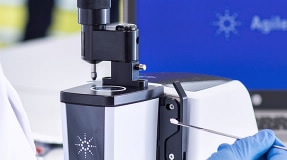
4300 Handheld FTIR has a range of sampling interfaces
4300 Handheld FTIR Sampling Accessories
To handle this range of applications, the system has five different sample interfaces that are instantaneously interchangeable, and provide a specific means of delivering light to the sample. These interfaces have radio frequency identification (RFID), providing seamless integration between the sample interface and specific software methods.
- FTIR Accessories
Request a Quote
Product Details
- The diamond ATR sample interface is ideal for the analysis of solids, liquids, pastes, and gels.
- The diffuse reflectance interface is suited for a wide variety of samples, including artwork, soils, rocks and minerals, composites, rough plastics, fabrics, and corrosion on metal surfaces.
- The specular reflectance interface allows the analysis of films and coatings on reflective metal surfaces such as aluminum or steel. The angle of incidence is 45 degrees.
- The grazing angle interface has an angle of incidence of 82 degrees making it ideal for the analysis of very thin (submicron) films. The Ge ATR sample interface (comprised of a germanium crystal) is ideal for the analysis of highly absorbing solids and liquids.
Reflectance FTIR Spectroscopy
Reflectance FTIR is used to acquire high quality spectral data from solid samples. Specular reflection is used with reflective surfaces, diffuse reflection (DRIFTS) works with rougher, less reflective surfaces (often powders), and reflection-absorption grazing angle FTIR measures sub-micron thin films and contaminants on surfaces.
Learn More- Key Literature
-
Agilent 4300 Handheld FTIR Spectrometer Brochure
At-site. Immediate results. True non-destructive analysis. Perform accurate, non-destructive material testing with the Agilent 4300 Handheld FTIR.
- Brochures
- English
- 01 Mar 2014
- 4.56 MB
Non-Destructive Analysis of Substrates and Contaminants by FTIR Specular Reflectance
Agilent 4300 handheld FTIR spectrometer with specular reflectance identifies substrate materials, evaluates presence of contaminants, quantifies contaminants.
- Application Notes
- English
- 24 May 2023
- 2.13 MB
Comparison of Portable FTIR Techniques for the Analysis of Paints, Minerals & Concrete
ATR, Diffuse Reflectance and 45 degree specular reflectance FTIR spectroscopy measurements were compared for paint, concrete and rock samples.
- Application Notes
- English
- 21 Aug 2017
- 1.25 MB
- Brochures
- Catalogs
- FAQs
-
Fourier Transform Infrared Spectroscopy (FTIR) Overview
Learn about infrared spectroscopy & FTIR spectroscopy—FAQs on how FTIR works, how FTIR spectrometers work, FTIR measurements, and techniques like ATR-FTIR
- Supplemental Information
More help is just a click away
If you didn't find what you need, try these resources or contact a specialist
FTIR Analysis & Applications Overview
A guide to modern applications of FTIR analysis using benchtop and handheld instruments.
ATR-FTIR Spectroscopy Overview
Learn about the most common FTIR sampling technique for measuring liquids, solids, powders, semisolids, and pastes.
Videos
Molecular Spectroscopy Webinar Curriculum
Molecular Spectroscopy Webinar Curriculum includes UV-Vis, UV-Vis-NIR, fluorescence, handheld and benchtop FTIR, and Raman systems for high performance and flexibility
Spectroscopy Digital Workshops & Bootcamps
Hone your lab skills, outside the lab, with our live, interactive series of virtual workshops and software bootcamps! Learn about the latest in software solutions for Spectroscopy, discuss the entire analytical process from method development to data analysis, and participate in live analytical runs with our experts. We hope these will prepare you for future hands-on events in the future.
Analysis of Lithium Ores Using Handheld Direct Diffuse Reflectance FTIR Spectroscopy
A new application note evaluates fast, direct, and non-destructive identification of rocks with a handheld 4300 FTIR in direct DRIFTS mode. Identify potential lithium ore mining sites with no need to excavate or transport materials to the laboratory. Simply point-and-shoot and match against a geological materials database or use quantification models to determine the amount of minerals within rocks.
- 04 Nov 2024
